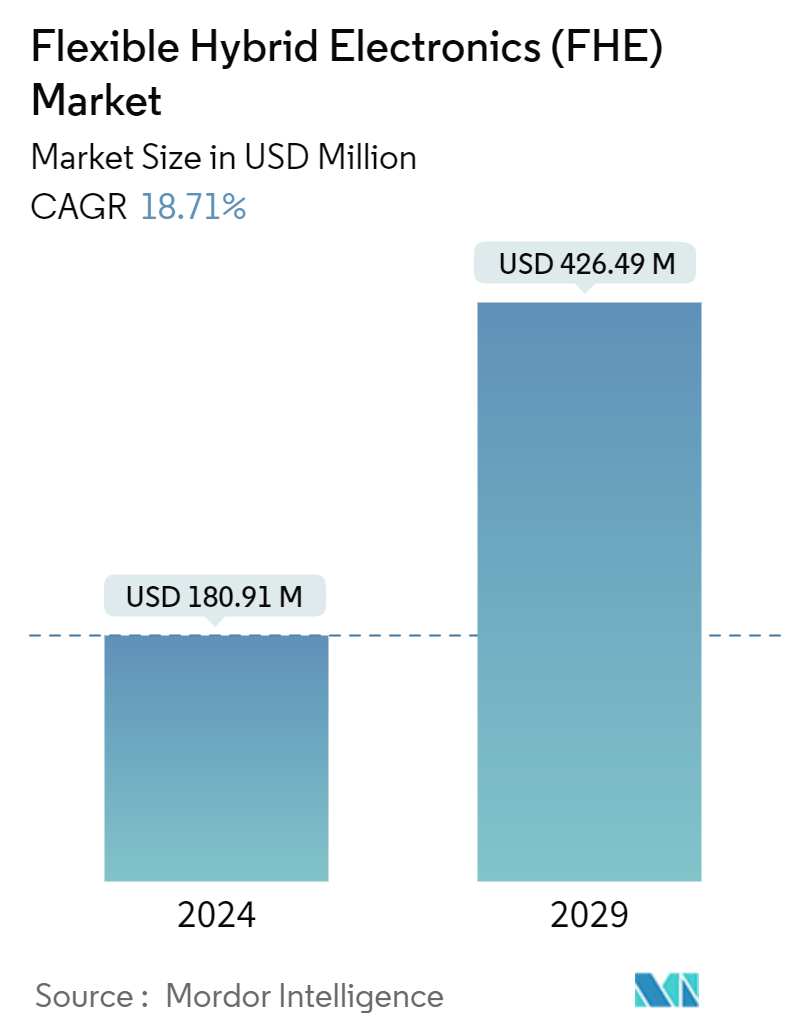Market Size of Flexible Hybrid Electronics (FHE) Industry

| Study Period | 2019 - 2029 |
| Market Size (2024) | USD 180.91 Million |
| Market Size (2029) | USD 426.49 Million |
| CAGR (2024 - 2029) | 18.71 % |
| Fastest Growing Market | Asia Pacific |
| Largest Market | North America |
Major Players
*Disclaimer: Major Players sorted in no particular order |
Flexible Hybrid Electronics (FHE) Market Analysis
The Flexible Hybrid Electronics Market size is estimated at USD 180.91 million in 2024, and is expected to reach USD 426.49 million by 2029, growing at a CAGR of 18.71% during the forecast period (2024-2029).
The increasing applications of these electronic components in wearable electronics, performance monitoring systems, structural health monitoring for constructions, soft robotics, and array antennas are expected to drive the market’s growth during the forecast period.
- Hybrid electronics combine the flexibility, lightweight nature, thinness, and large-area electronics with the processing power of semiconductors to open a broad range of new applications across different end-use applications, such as the Internet of Things (IoT), smart buildings, healthcare, product packaging, retail, and consumer electronics.
- Flexible hybrid electronics are also helping product designers use sensors in a new way to collect data and deliver actionable insights that enhance functioning. The growing development and innovations in the market are expected to revolutionize the electronics industry. With the advent of the IoT, flexible hybrid electronics are expected to provide massive opportunities to develop and integrate smart systems and devices for low-cost, everyday use. Industries like automotive, military, aerospace, healthcare, and displays are utilizing flexible and hybrid sensors and wearables in their products.
- Printed electronics is the process of creating electronic circuits and components on various substrates using printing processes such as screen printing, inkjet printing, and gravure printing. To create electrical devices, conductive inks consisting of silver, carbon nanotubes, or conductive polymers are applied to substrates. RFID tags, flexible displays, printed sensors, smart packaging, and e-textiles are a few examples of printed electronics applications. Lightweight, flexible components and scalable and affordable production procedures make them ideal for large-scale applications. Limited electrical performance compared to standard silicon-based devices, inferior durability, dependability, and material qualities hinder performance in demanding situations.
- There is an emerging need for lightweight, mechanically flexible, and cost-effective devices in medical, automotive, and consumer electronics applications. Flexible hybrid electronic devices have gained considerable momentum in catering to the industry’s needs. Flexible electronics have the potential to transform computing by enabling bendable systems with arbitrary shapes.
- Government funding boosts R&D activities, leading to innovations and technological advancements in FHE. This support helps overcome technical challenges, reduces costs, and enhances the performance and reliability of FHE products. The government provided funding for various initiatives, including NextFlex Project Call 4.0, the Semi-Flex Tech Project, and the HiFES (hybrid integrated flexible electronic systems) program.
- The high requirement for research and development (R&D) and infrastructure poses several challenges restraining the demand growth for flexible hybrid electronics (FHE). The significant upfront costs of R&D and infrastructure development deter potential adopters, including businesses and consumers, from investing in FHE technologies. This reluctance stems from concerns over return on investment (ROI) and the affordability of initial deployment.
- There is a greater need for business goods and services during economic expansion. Businesses frequently invest in technology like flexible hybrid electronics that can increase various industries because of this increase in demand for lightweight, flexible, and conformal designs. For instance, according to MOSPI, in the financial year 2023, the contribution of domestic electronics production value to the Indian GDP was about 2.9%. This contribution share was estimated to increase to 4.7% by the financial year 2026. Such possible expansion in electronics production is projected to increase demand in the market studied.
Flexible Hybrid Electronics (FHE) Industry Segmentation
Flexible hybrid electronics are the devices that combine the flexibility and low cost of printed plastic film substrates with the performance of semiconductor devices to create a new category of electronics. FHE is the convergence of additive circuitry, passive devices, and sensor systems typically manufactured using printing methods and thin, flexible silicon chips. The market is defined by the revenue generated through flexible hybrid electronics (FHE) solutions offered by various market players operating in the market.
The flexible hybrid electronics (FHE) market is segmented by application (electronics, health performance tools, security tag, and industrial and environmental monitoring) and by geography (North America, Europe, Asia Pacific, and the rest of the World). The report offers market forecasts and size in value (USD) for all the above segments.
| By Application | ||||
| Electronics | ||||
| ||||
| Security Tag | ||||
| Industrial and Environmental Monitoring |
| By Geography*** | |
| North America | |
| Europe | |
| Asia | |
| Australia and New Zealand | |
| Latin America | |
| Middle East and Africa |
Flexible Hybrid Electronics (FHE) Market Size Summary
The Flexible Hybrid Electronics (FHE) market is poised for significant growth, driven by its applications across various sectors such as wearable electronics, soft robotics, and the Internet of Things (IoT). This technology combines the flexibility and lightweight nature of printed electronics with the processing power of semiconductors, enabling new applications in smart buildings, healthcare, and consumer electronics. The integration of flexible hybrid electronics is expected to revolutionize the electronics industry by facilitating the development of smart systems and devices that are cost-effective and versatile. Despite challenges like high R&D costs and limited electrical performance compared to traditional silicon-based devices, the market is witnessing increased interest and investment, particularly in regions like North America and Asia-Pacific, where government support and industrial initiatives are fostering innovation and commercialization.
The market landscape is characterized by a high degree of fragmentation, with major players such as DuPont Teijin Films, General Electric Company, and Lockheed Martin Corporation actively engaging in partnerships and acquisitions to enhance their offerings. The Asia-Pacific region, with its robust semiconductor industry and growing demand for flexible consumer electronics, is a key area of growth. Companies in this region are leveraging advanced technologies and collaborations with academic institutions to drive innovation in flexible hybrid electronics. The market's expansion is further supported by initiatives like the NextFlex consortium in the United States, which aims to accelerate the commercialization of FHE technologies. As industries continue to seek lightweight, flexible, and cost-effective solutions, the FHE market is expected to experience substantial growth, offering numerous opportunities for technological advancements and market penetration.
Flexible Hybrid Electronics (FHE) Market Size - Table of Contents
-
1. MARKET INSIGHTS
-
1.1 Market Overview
-
1.2 Flexible Hybrid Electronics Ecosystem Analysis
-
1.3 Industry Attractiveness - Porter's Five Forces Analysis
-
1.3.1 Threat of New Entrants
-
1.3.2 Bargaining Power of Buyers/Consumers
-
1.3.3 Bargaining Power of Suppliers
-
1.3.4 Threat of Substitute Products
-
1.3.5 Intensity of Competitive Rivalry
-
-
1.4 Technology Snapshot and FHE Roadmap
-
-
2. MARKET SEGMENTATION
-
2.1 By Application
-
2.1.1 Electronics
-
2.1.2 Health Performance Tool
-
2.1.2.1 Application Summary and Market Potential
-
2.1.2.2 Use-cases
-
-
2.1.3 Security Tag
-
2.1.4 Industrial and Environmental Monitoring
-
-
2.2 By Geography***
-
2.2.1 North America
-
2.2.2 Europe
-
2.2.3 Asia
-
2.2.4 Australia and New Zealand
-
2.2.5 Latin America
-
2.2.6 Middle East and Africa
-
-
Flexible Hybrid Electronics (FHE) Market Size FAQs
How big is the Flexible Hybrid Electronics Market?
The Flexible Hybrid Electronics Market size is expected to reach USD 180.91 million in 2024 and grow at a CAGR of 18.71% to reach USD 426.49 million by 2029.
What is the current Flexible Hybrid Electronics Market size?
In 2024, the Flexible Hybrid Electronics Market size is expected to reach USD 180.91 million.

